Uber's Business Strategy Analysis: Internal and External Factors
VerifiedAdded on 2023/01/04
|19
|4794
|66
Report
AI Summary
This report provides a comprehensive business strategy analysis of Uber, examining both its internal and external environments. It begins with an introduction to business strategy and its importance in achieving a competitive advantage. The report then applies various frameworks, including PESTLE analysis to assess the macro-environment, and VRIO analysis to evaluate Uber's internal capabilities and resources. SWOT analysis is used to determine the strengths, weaknesses, opportunities, and threats. Porter's Five Forces model is applied to analyze the competitive forces within the ride-hailing industry. The report concludes with a strategic plan based on the analysis, outlining strategic priorities and objectives, and offering recommendations for Uber's future growth and competitive positioning. The report also discusses the impact of political, economic, social, technological, legal, and environmental factors on Uber's operations, and how the company can leverage its strengths and mitigate its weaknesses to capitalize on opportunities and address threats.
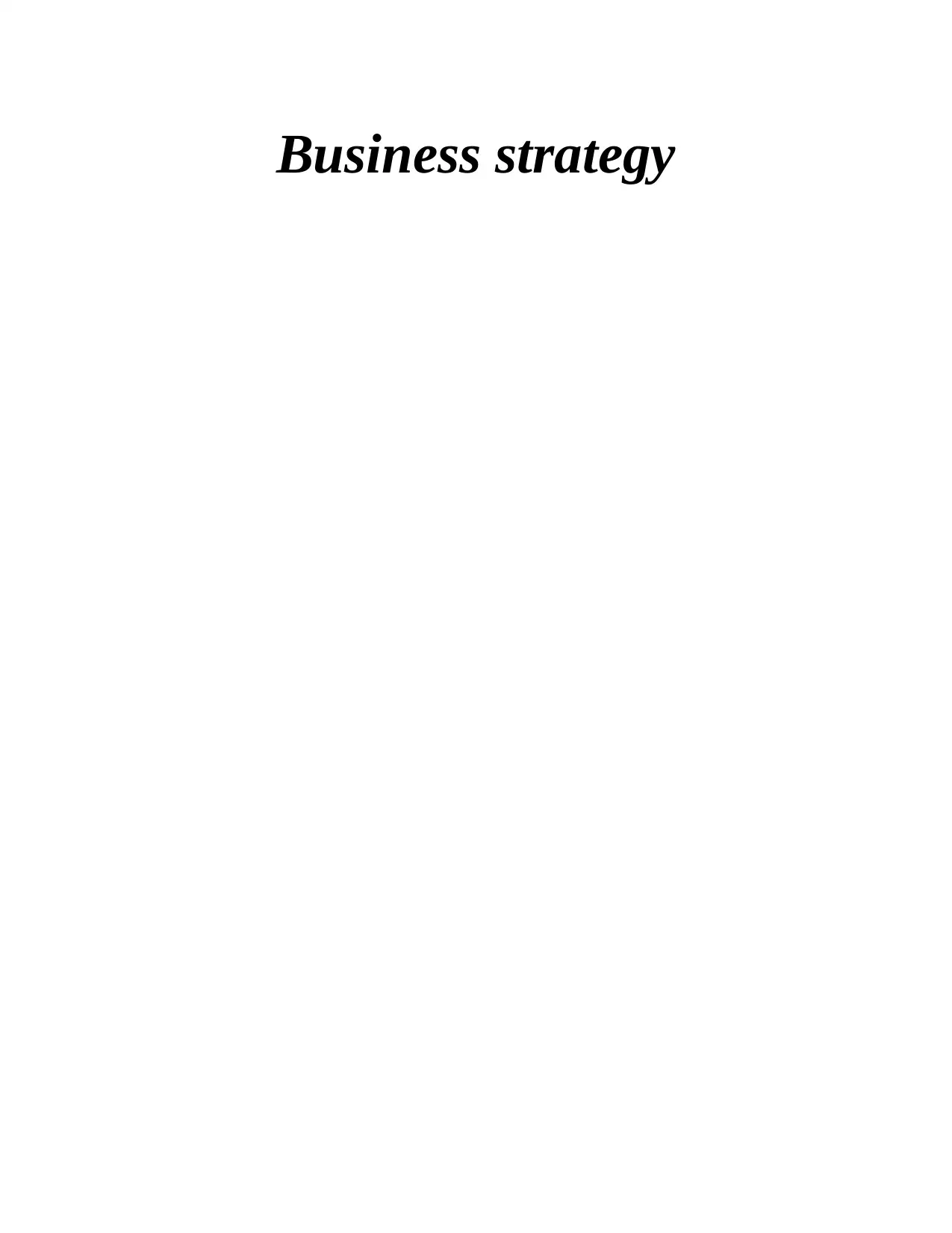
Business strategy
Paraphrase This Document
Need a fresh take? Get an instant paraphrase of this document with our AI Paraphraser
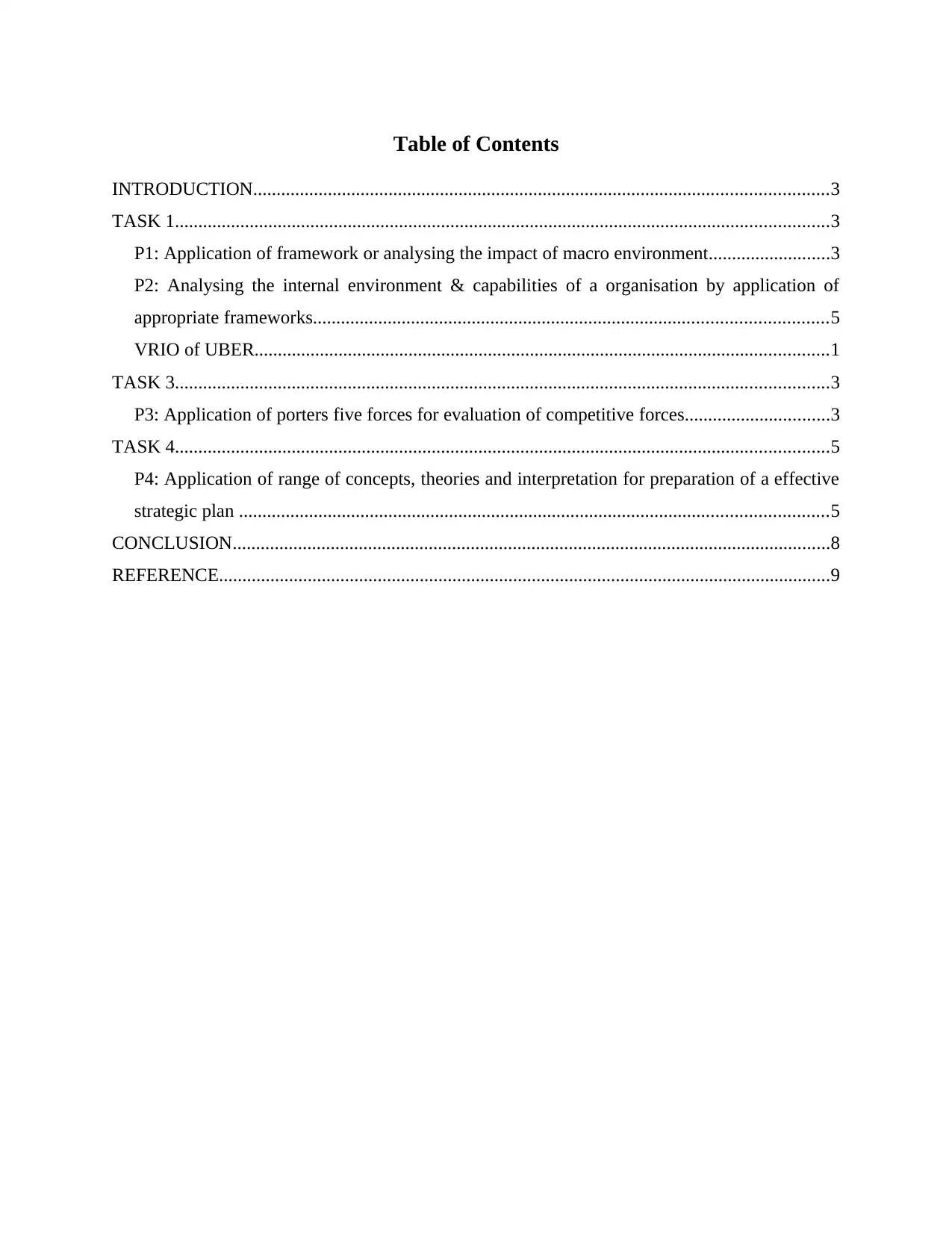
Table of Contents
INTRODUCTION...........................................................................................................................3
TASK 1............................................................................................................................................3
P1: Application of framework or analysing the impact of macro environment..........................3
P2: Analysing the internal environment & capabilities of a organisation by application of
appropriate frameworks..............................................................................................................5
VRIO of UBER...........................................................................................................................1
TASK 3............................................................................................................................................3
P3: Application of porters five forces for evaluation of competitive forces...............................3
TASK 4............................................................................................................................................5
P4: Application of range of concepts, theories and interpretation for preparation of a effective
strategic plan ..............................................................................................................................5
CONCLUSION................................................................................................................................8
REFERENCE...................................................................................................................................9
INTRODUCTION...........................................................................................................................3
TASK 1............................................................................................................................................3
P1: Application of framework or analysing the impact of macro environment..........................3
P2: Analysing the internal environment & capabilities of a organisation by application of
appropriate frameworks..............................................................................................................5
VRIO of UBER...........................................................................................................................1
TASK 3............................................................................................................................................3
P3: Application of porters five forces for evaluation of competitive forces...............................3
TASK 4............................................................................................................................................5
P4: Application of range of concepts, theories and interpretation for preparation of a effective
strategic plan ..............................................................................................................................5
CONCLUSION................................................................................................................................8
REFERENCE...................................................................................................................................9
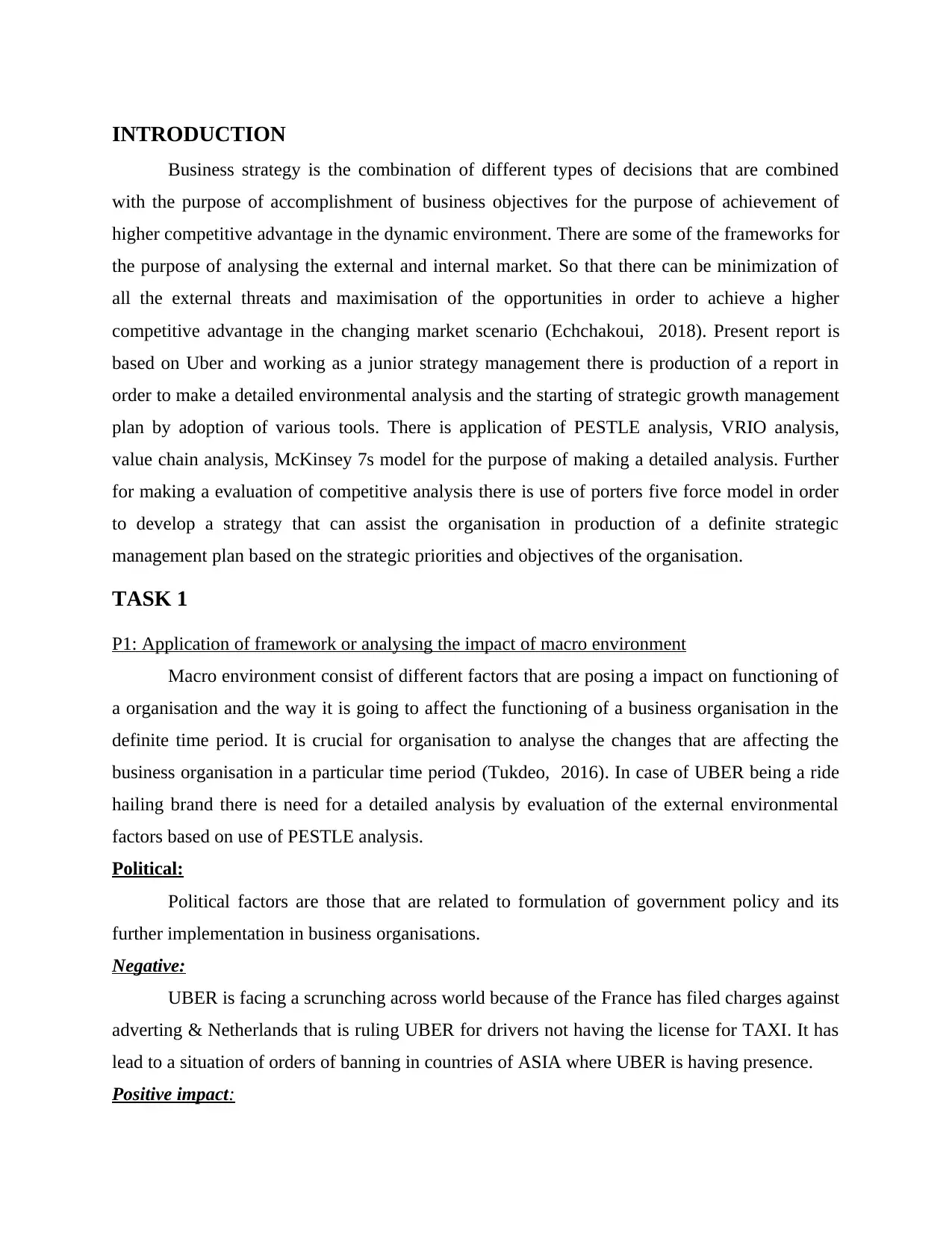
INTRODUCTION
Business strategy is the combination of different types of decisions that are combined
with the purpose of accomplishment of business objectives for the purpose of achievement of
higher competitive advantage in the dynamic environment. There are some of the frameworks for
the purpose of analysing the external and internal market. So that there can be minimization of
all the external threats and maximisation of the opportunities in order to achieve a higher
competitive advantage in the changing market scenario (Echchakoui, 2018). Present report is
based on Uber and working as a junior strategy management there is production of a report in
order to make a detailed environmental analysis and the starting of strategic growth management
plan by adoption of various tools. There is application of PESTLE analysis, VRIO analysis,
value chain analysis, McKinsey 7s model for the purpose of making a detailed analysis. Further
for making a evaluation of competitive analysis there is use of porters five force model in order
to develop a strategy that can assist the organisation in production of a definite strategic
management plan based on the strategic priorities and objectives of the organisation.
TASK 1
P1: Application of framework or analysing the impact of macro environment
Macro environment consist of different factors that are posing a impact on functioning of
a organisation and the way it is going to affect the functioning of a business organisation in the
definite time period. It is crucial for organisation to analyse the changes that are affecting the
business organisation in a particular time period (Tukdeo, 2016). In case of UBER being a ride
hailing brand there is need for a detailed analysis by evaluation of the external environmental
factors based on use of PESTLE analysis.
Political:
Political factors are those that are related to formulation of government policy and its
further implementation in business organisations.
Negative:
UBER is facing a scrunching across world because of the France has filed charges against
adverting & Netherlands that is ruling UBER for drivers not having the license for TAXI. It has
lead to a situation of orders of banning in countries of ASIA where UBER is having presence.
Positive impact:
Business strategy is the combination of different types of decisions that are combined
with the purpose of accomplishment of business objectives for the purpose of achievement of
higher competitive advantage in the dynamic environment. There are some of the frameworks for
the purpose of analysing the external and internal market. So that there can be minimization of
all the external threats and maximisation of the opportunities in order to achieve a higher
competitive advantage in the changing market scenario (Echchakoui, 2018). Present report is
based on Uber and working as a junior strategy management there is production of a report in
order to make a detailed environmental analysis and the starting of strategic growth management
plan by adoption of various tools. There is application of PESTLE analysis, VRIO analysis,
value chain analysis, McKinsey 7s model for the purpose of making a detailed analysis. Further
for making a evaluation of competitive analysis there is use of porters five force model in order
to develop a strategy that can assist the organisation in production of a definite strategic
management plan based on the strategic priorities and objectives of the organisation.
TASK 1
P1: Application of framework or analysing the impact of macro environment
Macro environment consist of different factors that are posing a impact on functioning of
a organisation and the way it is going to affect the functioning of a business organisation in the
definite time period. It is crucial for organisation to analyse the changes that are affecting the
business organisation in a particular time period (Tukdeo, 2016). In case of UBER being a ride
hailing brand there is need for a detailed analysis by evaluation of the external environmental
factors based on use of PESTLE analysis.
Political:
Political factors are those that are related to formulation of government policy and its
further implementation in business organisations.
Negative:
UBER is facing a scrunching across world because of the France has filed charges against
adverting & Netherlands that is ruling UBER for drivers not having the license for TAXI. It has
lead to a situation of orders of banning in countries of ASIA where UBER is having presence.
Positive impact:
⊘ This is a preview!⊘
Do you want full access?
Subscribe today to unlock all pages.

Trusted by 1+ million students worldwide
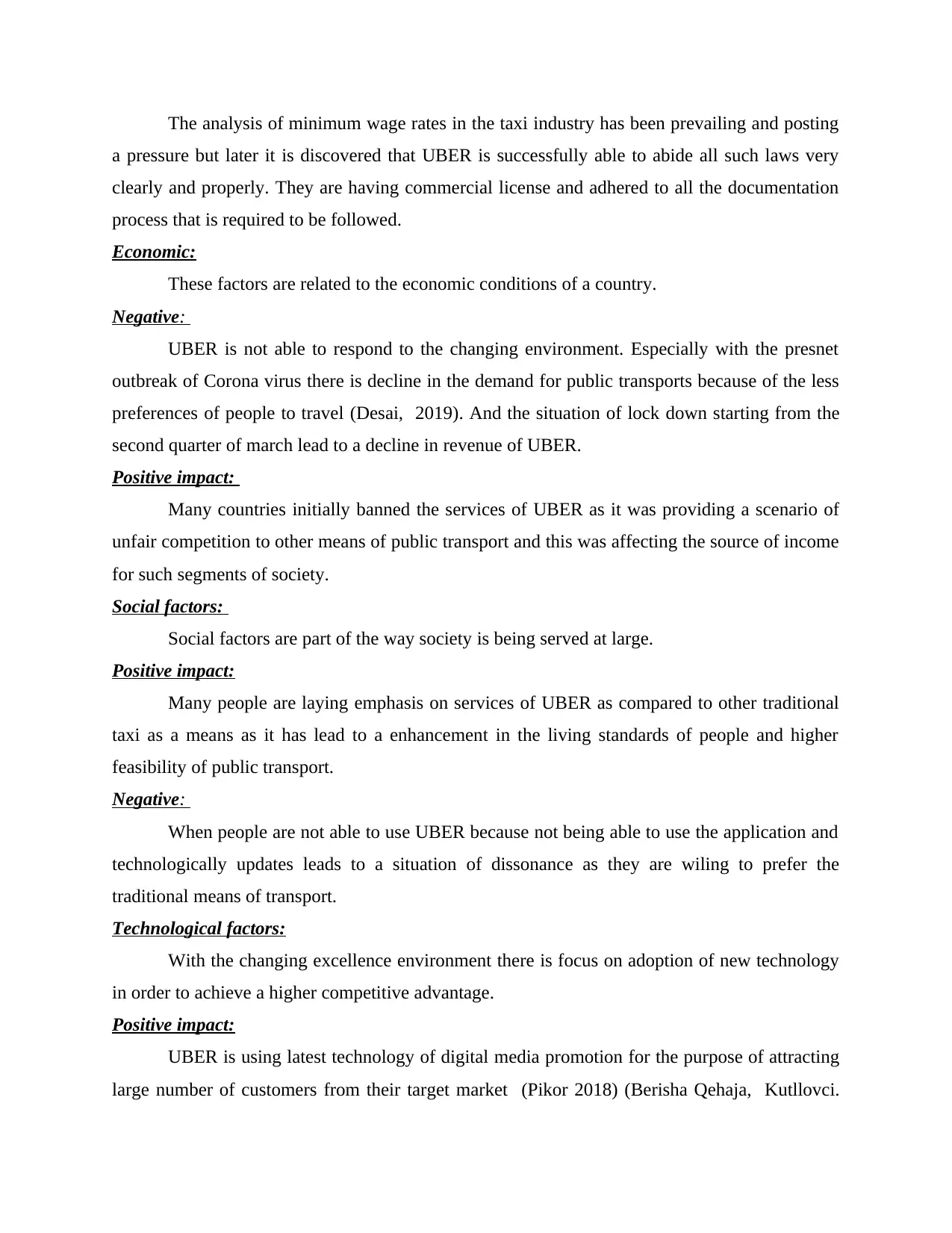
The analysis of minimum wage rates in the taxi industry has been prevailing and posting
a pressure but later it is discovered that UBER is successfully able to abide all such laws very
clearly and properly. They are having commercial license and adhered to all the documentation
process that is required to be followed.
Economic:
These factors are related to the economic conditions of a country.
Negative:
UBER is not able to respond to the changing environment. Especially with the presnet
outbreak of Corona virus there is decline in the demand for public transports because of the less
preferences of people to travel (Desai, 2019). And the situation of lock down starting from the
second quarter of march lead to a decline in revenue of UBER.
Positive impact:
Many countries initially banned the services of UBER as it was providing a scenario of
unfair competition to other means of public transport and this was affecting the source of income
for such segments of society.
Social factors:
Social factors are part of the way society is being served at large.
Positive impact:
Many people are laying emphasis on services of UBER as compared to other traditional
taxi as a means as it has lead to a enhancement in the living standards of people and higher
feasibility of public transport.
Negative:
When people are not able to use UBER because not being able to use the application and
technologically updates leads to a situation of dissonance as they are wiling to prefer the
traditional means of transport.
Technological factors:
With the changing excellence environment there is focus on adoption of new technology
in order to achieve a higher competitive advantage.
Positive impact:
UBER is using latest technology of digital media promotion for the purpose of attracting
large number of customers from their target market (Pikor 2018) (Berisha Qehaja, Kutllovci.
a pressure but later it is discovered that UBER is successfully able to abide all such laws very
clearly and properly. They are having commercial license and adhered to all the documentation
process that is required to be followed.
Economic:
These factors are related to the economic conditions of a country.
Negative:
UBER is not able to respond to the changing environment. Especially with the presnet
outbreak of Corona virus there is decline in the demand for public transports because of the less
preferences of people to travel (Desai, 2019). And the situation of lock down starting from the
second quarter of march lead to a decline in revenue of UBER.
Positive impact:
Many countries initially banned the services of UBER as it was providing a scenario of
unfair competition to other means of public transport and this was affecting the source of income
for such segments of society.
Social factors:
Social factors are part of the way society is being served at large.
Positive impact:
Many people are laying emphasis on services of UBER as compared to other traditional
taxi as a means as it has lead to a enhancement in the living standards of people and higher
feasibility of public transport.
Negative:
When people are not able to use UBER because not being able to use the application and
technologically updates leads to a situation of dissonance as they are wiling to prefer the
traditional means of transport.
Technological factors:
With the changing excellence environment there is focus on adoption of new technology
in order to achieve a higher competitive advantage.
Positive impact:
UBER is using latest technology of digital media promotion for the purpose of attracting
large number of customers from their target market (Pikor 2018) (Berisha Qehaja, Kutllovci.
Paraphrase This Document
Need a fresh take? Get an instant paraphrase of this document with our AI Paraphraser
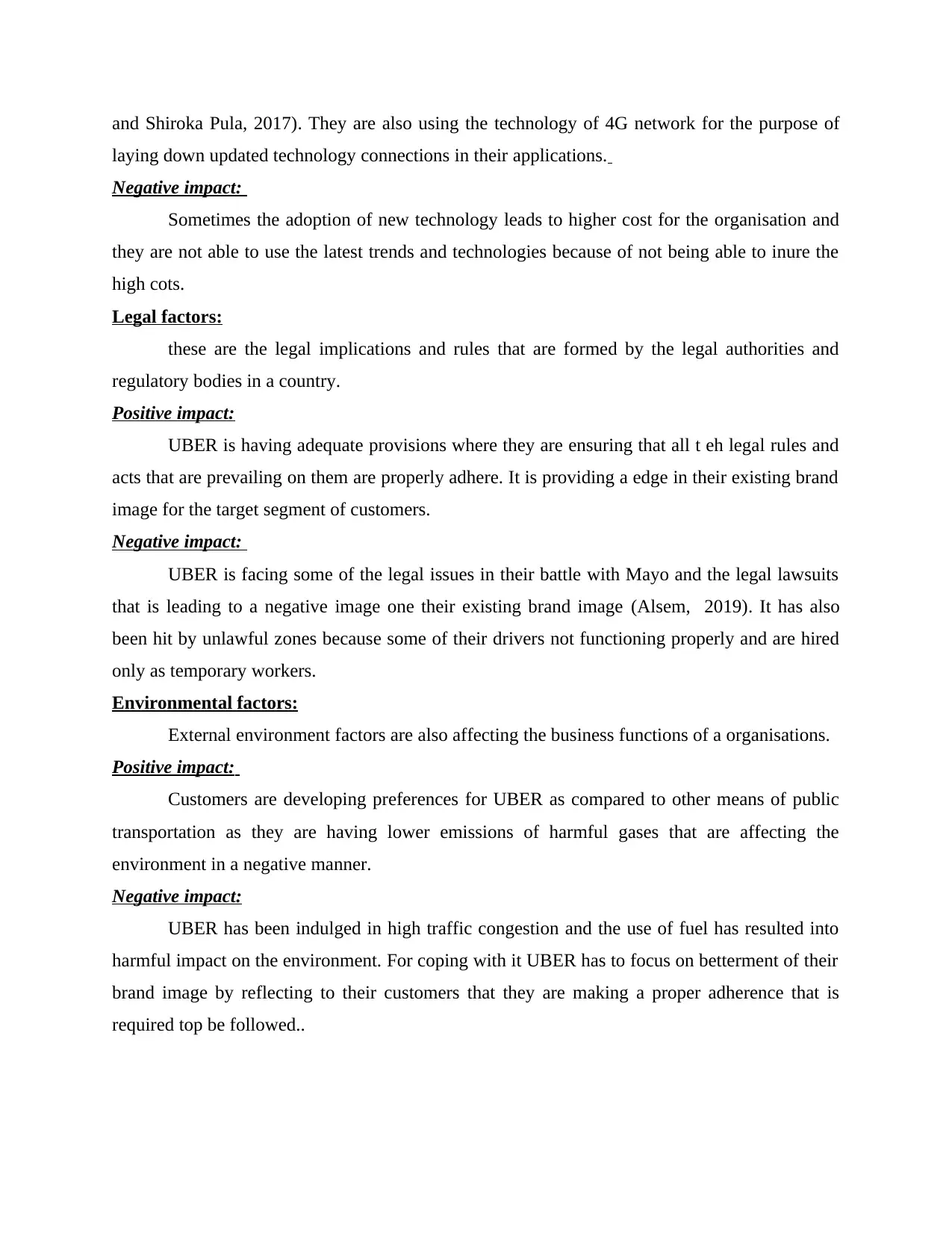
and Shiroka Pula, 2017). They are also using the technology of 4G network for the purpose of
laying down updated technology connections in their applications.
Negative impact:
Sometimes the adoption of new technology leads to higher cost for the organisation and
they are not able to use the latest trends and technologies because of not being able to inure the
high cots.
Legal factors:
these are the legal implications and rules that are formed by the legal authorities and
regulatory bodies in a country.
Positive impact:
UBER is having adequate provisions where they are ensuring that all t eh legal rules and
acts that are prevailing on them are properly adhere. It is providing a edge in their existing brand
image for the target segment of customers.
Negative impact:
UBER is facing some of the legal issues in their battle with Mayo and the legal lawsuits
that is leading to a negative image one their existing brand image (Alsem, 2019). It has also
been hit by unlawful zones because some of their drivers not functioning properly and are hired
only as temporary workers.
Environmental factors:
External environment factors are also affecting the business functions of a organisations.
Positive impact:
Customers are developing preferences for UBER as compared to other means of public
transportation as they are having lower emissions of harmful gases that are affecting the
environment in a negative manner.
Negative impact:
UBER has been indulged in high traffic congestion and the use of fuel has resulted into
harmful impact on the environment. For coping with it UBER has to focus on betterment of their
brand image by reflecting to their customers that they are making a proper adherence that is
required top be followed..
laying down updated technology connections in their applications.
Negative impact:
Sometimes the adoption of new technology leads to higher cost for the organisation and
they are not able to use the latest trends and technologies because of not being able to inure the
high cots.
Legal factors:
these are the legal implications and rules that are formed by the legal authorities and
regulatory bodies in a country.
Positive impact:
UBER is having adequate provisions where they are ensuring that all t eh legal rules and
acts that are prevailing on them are properly adhere. It is providing a edge in their existing brand
image for the target segment of customers.
Negative impact:
UBER is facing some of the legal issues in their battle with Mayo and the legal lawsuits
that is leading to a negative image one their existing brand image (Alsem, 2019). It has also
been hit by unlawful zones because some of their drivers not functioning properly and are hired
only as temporary workers.
Environmental factors:
External environment factors are also affecting the business functions of a organisations.
Positive impact:
Customers are developing preferences for UBER as compared to other means of public
transportation as they are having lower emissions of harmful gases that are affecting the
environment in a negative manner.
Negative impact:
UBER has been indulged in high traffic congestion and the use of fuel has resulted into
harmful impact on the environment. For coping with it UBER has to focus on betterment of their
brand image by reflecting to their customers that they are making a proper adherence that is
required top be followed..
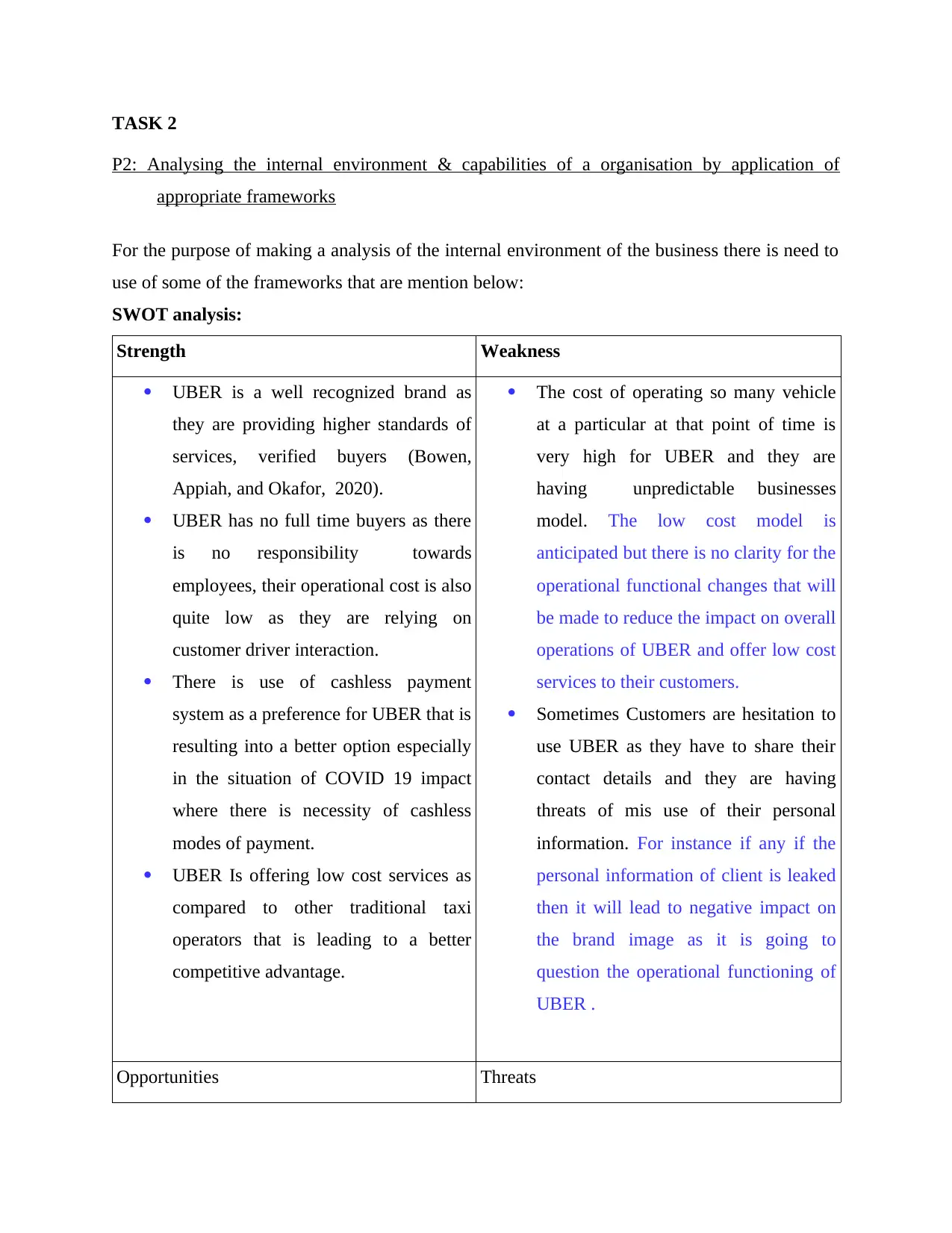
TASK 2
P2: Analysing the internal environment & capabilities of a organisation by application of
appropriate frameworks
For the purpose of making a analysis of the internal environment of the business there is need to
use of some of the frameworks that are mention below:
SWOT analysis:
Strength Weakness
UBER is a well recognized brand as
they are providing higher standards of
services, verified buyers (Bowen,
Appiah, and Okafor, 2020).
UBER has no full time buyers as there
is no responsibility towards
employees, their operational cost is also
quite low as they are relying on
customer driver interaction.
There is use of cashless payment
system as a preference for UBER that is
resulting into a better option especially
in the situation of COVID 19 impact
where there is necessity of cashless
modes of payment.
UBER Is offering low cost services as
compared to other traditional taxi
operators that is leading to a better
competitive advantage.
The cost of operating so many vehicle
at a particular at that point of time is
very high for UBER and they are
having unpredictable businesses
model. The low cost model is
anticipated but there is no clarity for the
operational functional changes that will
be made to reduce the impact on overall
operations of UBER and offer low cost
services to their customers.
Sometimes Customers are hesitation to
use UBER as they have to share their
contact details and they are having
threats of mis use of their personal
information. For instance if any if the
personal information of client is leaked
then it will lead to negative impact on
the brand image as it is going to
question the operational functioning of
UBER .
Opportunities Threats
P2: Analysing the internal environment & capabilities of a organisation by application of
appropriate frameworks
For the purpose of making a analysis of the internal environment of the business there is need to
use of some of the frameworks that are mention below:
SWOT analysis:
Strength Weakness
UBER is a well recognized brand as
they are providing higher standards of
services, verified buyers (Bowen,
Appiah, and Okafor, 2020).
UBER has no full time buyers as there
is no responsibility towards
employees, their operational cost is also
quite low as they are relying on
customer driver interaction.
There is use of cashless payment
system as a preference for UBER that is
resulting into a better option especially
in the situation of COVID 19 impact
where there is necessity of cashless
modes of payment.
UBER Is offering low cost services as
compared to other traditional taxi
operators that is leading to a better
competitive advantage.
The cost of operating so many vehicle
at a particular at that point of time is
very high for UBER and they are
having unpredictable businesses
model. The low cost model is
anticipated but there is no clarity for the
operational functional changes that will
be made to reduce the impact on overall
operations of UBER and offer low cost
services to their customers.
Sometimes Customers are hesitation to
use UBER as they have to share their
contact details and they are having
threats of mis use of their personal
information. For instance if any if the
personal information of client is leaked
then it will lead to negative impact on
the brand image as it is going to
question the operational functioning of
UBER .
Opportunities Threats
⊘ This is a preview!⊘
Do you want full access?
Subscribe today to unlock all pages.

Trusted by 1+ million students worldwide
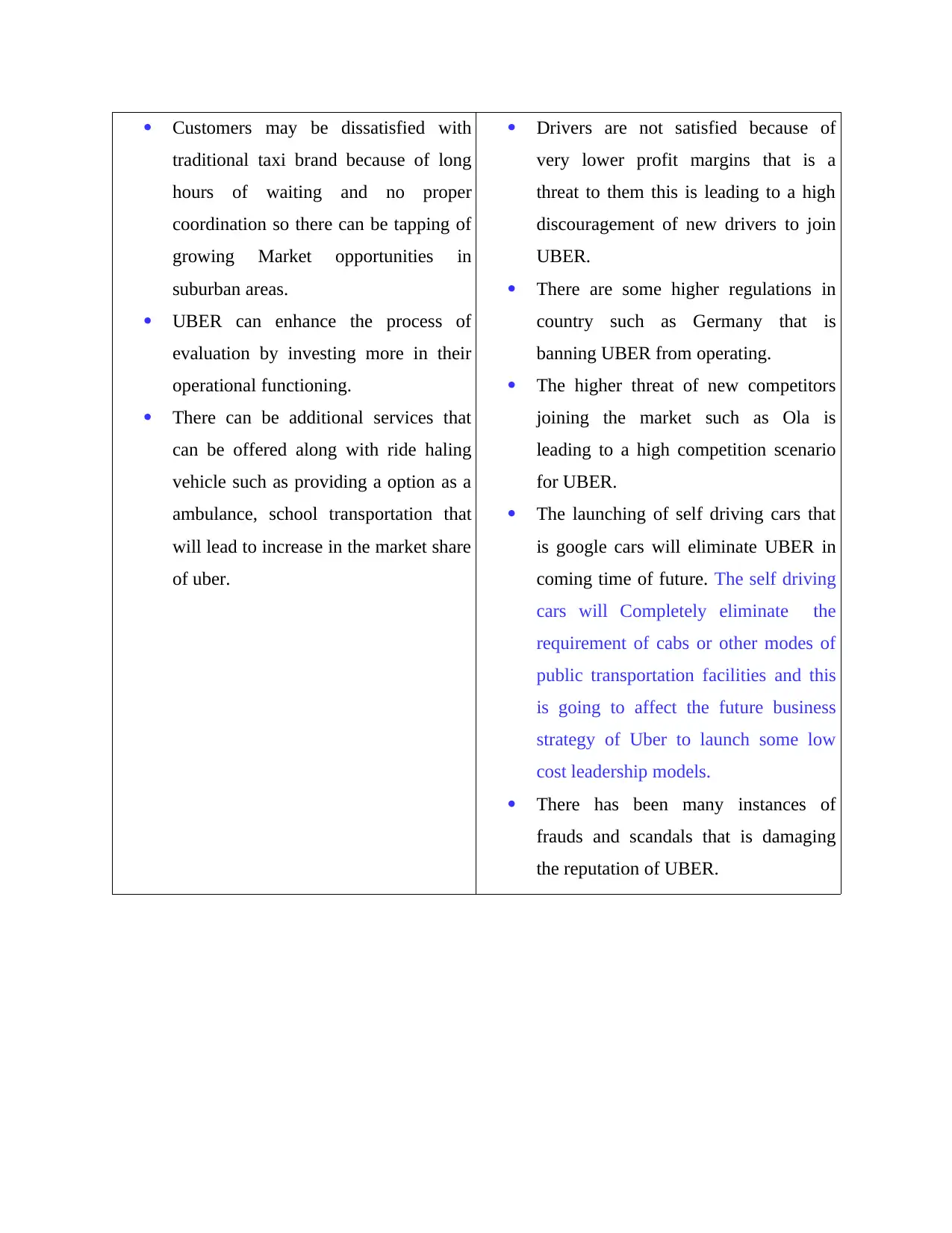
Customers may be dissatisfied with
traditional taxi brand because of long
hours of waiting and no proper
coordination so there can be tapping of
growing Market opportunities in
suburban areas.
UBER can enhance the process of
evaluation by investing more in their
operational functioning.
There can be additional services that
can be offered along with ride haling
vehicle such as providing a option as a
ambulance, school transportation that
will lead to increase in the market share
of uber.
Drivers are not satisfied because of
very lower profit margins that is a
threat to them this is leading to a high
discouragement of new drivers to join
UBER.
There are some higher regulations in
country such as Germany that is
banning UBER from operating.
The higher threat of new competitors
joining the market such as Ola is
leading to a high competition scenario
for UBER.
The launching of self driving cars that
is google cars will eliminate UBER in
coming time of future. The self driving
cars will Completely eliminate the
requirement of cabs or other modes of
public transportation facilities and this
is going to affect the future business
strategy of Uber to launch some low
cost leadership models.
There has been many instances of
frauds and scandals that is damaging
the reputation of UBER.
traditional taxi brand because of long
hours of waiting and no proper
coordination so there can be tapping of
growing Market opportunities in
suburban areas.
UBER can enhance the process of
evaluation by investing more in their
operational functioning.
There can be additional services that
can be offered along with ride haling
vehicle such as providing a option as a
ambulance, school transportation that
will lead to increase in the market share
of uber.
Drivers are not satisfied because of
very lower profit margins that is a
threat to them this is leading to a high
discouragement of new drivers to join
UBER.
There are some higher regulations in
country such as Germany that is
banning UBER from operating.
The higher threat of new competitors
joining the market such as Ola is
leading to a high competition scenario
for UBER.
The launching of self driving cars that
is google cars will eliminate UBER in
coming time of future. The self driving
cars will Completely eliminate the
requirement of cabs or other modes of
public transportation facilities and this
is going to affect the future business
strategy of Uber to launch some low
cost leadership models.
There has been many instances of
frauds and scandals that is damaging
the reputation of UBER.
Paraphrase This Document
Need a fresh take? Get an instant paraphrase of this document with our AI Paraphraser
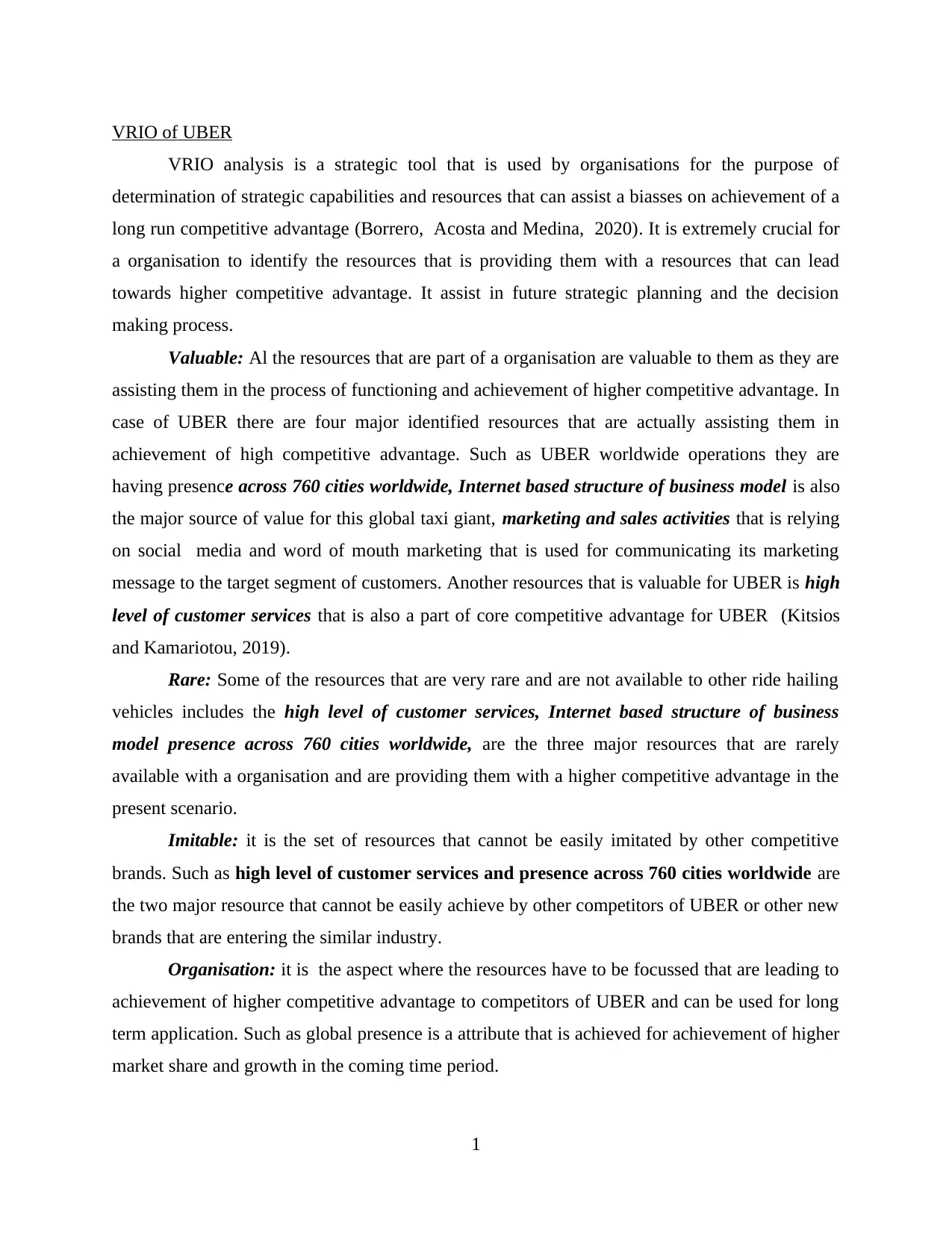
VRIO of UBER
VRIO analysis is a strategic tool that is used by organisations for the purpose of
determination of strategic capabilities and resources that can assist a biasses on achievement of a
long run competitive advantage (Borrero, Acosta and Medina, 2020). It is extremely crucial for
a organisation to identify the resources that is providing them with a resources that can lead
towards higher competitive advantage. It assist in future strategic planning and the decision
making process.
Valuable: Al the resources that are part of a organisation are valuable to them as they are
assisting them in the process of functioning and achievement of higher competitive advantage. In
case of UBER there are four major identified resources that are actually assisting them in
achievement of high competitive advantage. Such as UBER worldwide operations they are
having presence across 760 cities worldwide, Internet based structure of business model is also
the major source of value for this global taxi giant, marketing and sales activities that is relying
on social media and word of mouth marketing that is used for communicating its marketing
message to the target segment of customers. Another resources that is valuable for UBER is high
level of customer services that is also a part of core competitive advantage for UBER (Kitsios
and Kamariotou, 2019).
Rare: Some of the resources that are very rare and are not available to other ride hailing
vehicles includes the high level of customer services, Internet based structure of business
model presence across 760 cities worldwide, are the three major resources that are rarely
available with a organisation and are providing them with a higher competitive advantage in the
present scenario.
Imitable: it is the set of resources that cannot be easily imitated by other competitive
brands. Such as high level of customer services and presence across 760 cities worldwide are
the two major resource that cannot be easily achieve by other competitors of UBER or other new
brands that are entering the similar industry.
Organisation: it is the aspect where the resources have to be focussed that are leading to
achievement of higher competitive advantage to competitors of UBER and can be used for long
term application. Such as global presence is a attribute that is achieved for achievement of higher
market share and growth in the coming time period.
1
VRIO analysis is a strategic tool that is used by organisations for the purpose of
determination of strategic capabilities and resources that can assist a biasses on achievement of a
long run competitive advantage (Borrero, Acosta and Medina, 2020). It is extremely crucial for
a organisation to identify the resources that is providing them with a resources that can lead
towards higher competitive advantage. It assist in future strategic planning and the decision
making process.
Valuable: Al the resources that are part of a organisation are valuable to them as they are
assisting them in the process of functioning and achievement of higher competitive advantage. In
case of UBER there are four major identified resources that are actually assisting them in
achievement of high competitive advantage. Such as UBER worldwide operations they are
having presence across 760 cities worldwide, Internet based structure of business model is also
the major source of value for this global taxi giant, marketing and sales activities that is relying
on social media and word of mouth marketing that is used for communicating its marketing
message to the target segment of customers. Another resources that is valuable for UBER is high
level of customer services that is also a part of core competitive advantage for UBER (Kitsios
and Kamariotou, 2019).
Rare: Some of the resources that are very rare and are not available to other ride hailing
vehicles includes the high level of customer services, Internet based structure of business
model presence across 760 cities worldwide, are the three major resources that are rarely
available with a organisation and are providing them with a higher competitive advantage in the
present scenario.
Imitable: it is the set of resources that cannot be easily imitated by other competitive
brands. Such as high level of customer services and presence across 760 cities worldwide are
the two major resource that cannot be easily achieve by other competitors of UBER or other new
brands that are entering the similar industry.
Organisation: it is the aspect where the resources have to be focussed that are leading to
achievement of higher competitive advantage to competitors of UBER and can be used for long
term application. Such as global presence is a attribute that is achieved for achievement of higher
market share and growth in the coming time period.
1
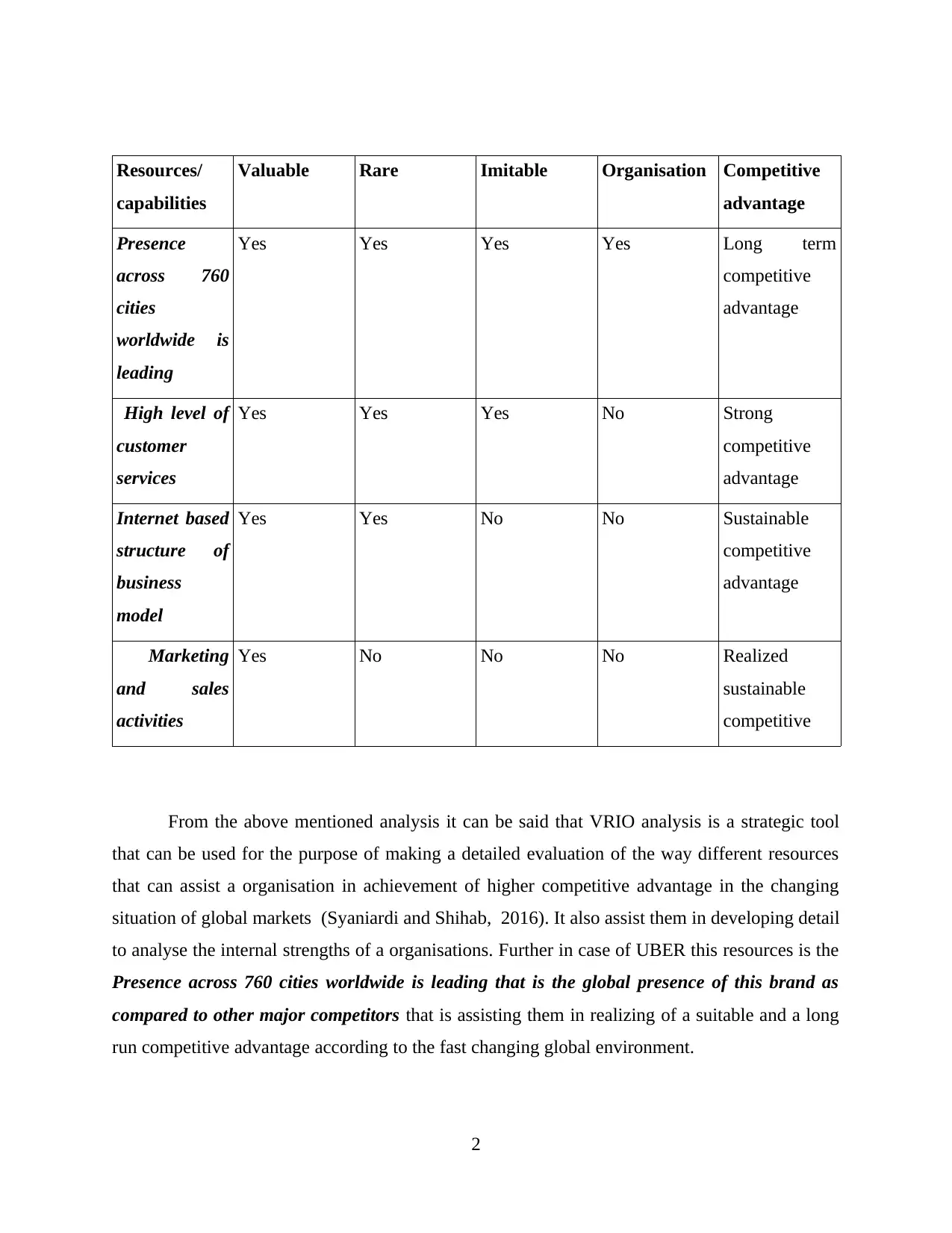
Resources/
capabilities
Valuable Rare Imitable Organisation Competitive
advantage
Presence
across 760
cities
worldwide is
leading
Yes Yes Yes Yes Long term
competitive
advantage
High level of
customer
services
Yes Yes Yes No Strong
competitive
advantage
Internet based
structure of
business
model
Yes Yes No No Sustainable
competitive
advantage
Marketing
and sales
activities
Yes No No No Realized
sustainable
competitive
From the above mentioned analysis it can be said that VRIO analysis is a strategic tool
that can be used for the purpose of making a detailed evaluation of the way different resources
that can assist a organisation in achievement of higher competitive advantage in the changing
situation of global markets (Syaniardi and Shihab, 2016). It also assist them in developing detail
to analyse the internal strengths of a organisations. Further in case of UBER this resources is the
Presence across 760 cities worldwide is leading that is the global presence of this brand as
compared to other major competitors that is assisting them in realizing of a suitable and a long
run competitive advantage according to the fast changing global environment.
2
capabilities
Valuable Rare Imitable Organisation Competitive
advantage
Presence
across 760
cities
worldwide is
leading
Yes Yes Yes Yes Long term
competitive
advantage
High level of
customer
services
Yes Yes Yes No Strong
competitive
advantage
Internet based
structure of
business
model
Yes Yes No No Sustainable
competitive
advantage
Marketing
and sales
activities
Yes No No No Realized
sustainable
competitive
From the above mentioned analysis it can be said that VRIO analysis is a strategic tool
that can be used for the purpose of making a detailed evaluation of the way different resources
that can assist a organisation in achievement of higher competitive advantage in the changing
situation of global markets (Syaniardi and Shihab, 2016). It also assist them in developing detail
to analyse the internal strengths of a organisations. Further in case of UBER this resources is the
Presence across 760 cities worldwide is leading that is the global presence of this brand as
compared to other major competitors that is assisting them in realizing of a suitable and a long
run competitive advantage according to the fast changing global environment.
2
⊘ This is a preview!⊘
Do you want full access?
Subscribe today to unlock all pages.

Trusted by 1+ million students worldwide
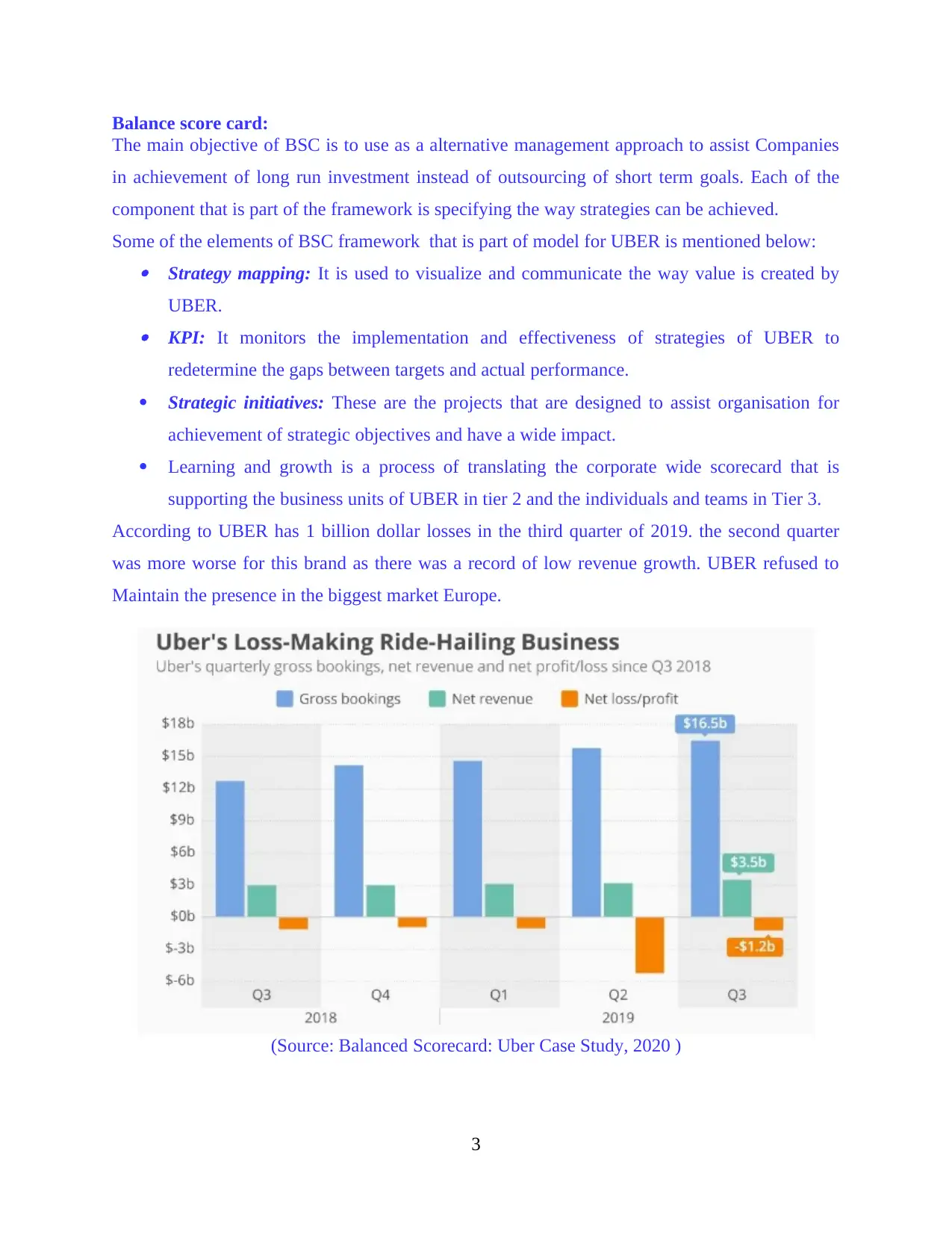
Balance score card:
The main objective of BSC is to use as a alternative management approach to assist Companies
in achievement of long run investment instead of outsourcing of short term goals. Each of the
component that is part of the framework is specifying the way strategies can be achieved.
Some of the elements of BSC framework that is part of model for UBER is mentioned below: Strategy mapping: It is used to visualize and communicate the way value is created by
UBER. KPI: It monitors the implementation and effectiveness of strategies of UBER to
redetermine the gaps between targets and actual performance.
Strategic initiatives: These are the projects that are designed to assist organisation for
achievement of strategic objectives and have a wide impact.
Learning and growth is a process of translating the corporate wide scorecard that is
supporting the business units of UBER in tier 2 and the individuals and teams in Tier 3.
According to UBER has 1 billion dollar losses in the third quarter of 2019. the second quarter
was more worse for this brand as there was a record of low revenue growth. UBER refused to
Maintain the presence in the biggest market Europe.
(Source: Balanced Scorecard: Uber Case Study, 2020 )
3
The main objective of BSC is to use as a alternative management approach to assist Companies
in achievement of long run investment instead of outsourcing of short term goals. Each of the
component that is part of the framework is specifying the way strategies can be achieved.
Some of the elements of BSC framework that is part of model for UBER is mentioned below: Strategy mapping: It is used to visualize and communicate the way value is created by
UBER. KPI: It monitors the implementation and effectiveness of strategies of UBER to
redetermine the gaps between targets and actual performance.
Strategic initiatives: These are the projects that are designed to assist organisation for
achievement of strategic objectives and have a wide impact.
Learning and growth is a process of translating the corporate wide scorecard that is
supporting the business units of UBER in tier 2 and the individuals and teams in Tier 3.
According to UBER has 1 billion dollar losses in the third quarter of 2019. the second quarter
was more worse for this brand as there was a record of low revenue growth. UBER refused to
Maintain the presence in the biggest market Europe.
(Source: Balanced Scorecard: Uber Case Study, 2020 )
3
Paraphrase This Document
Need a fresh take? Get an instant paraphrase of this document with our AI Paraphraser
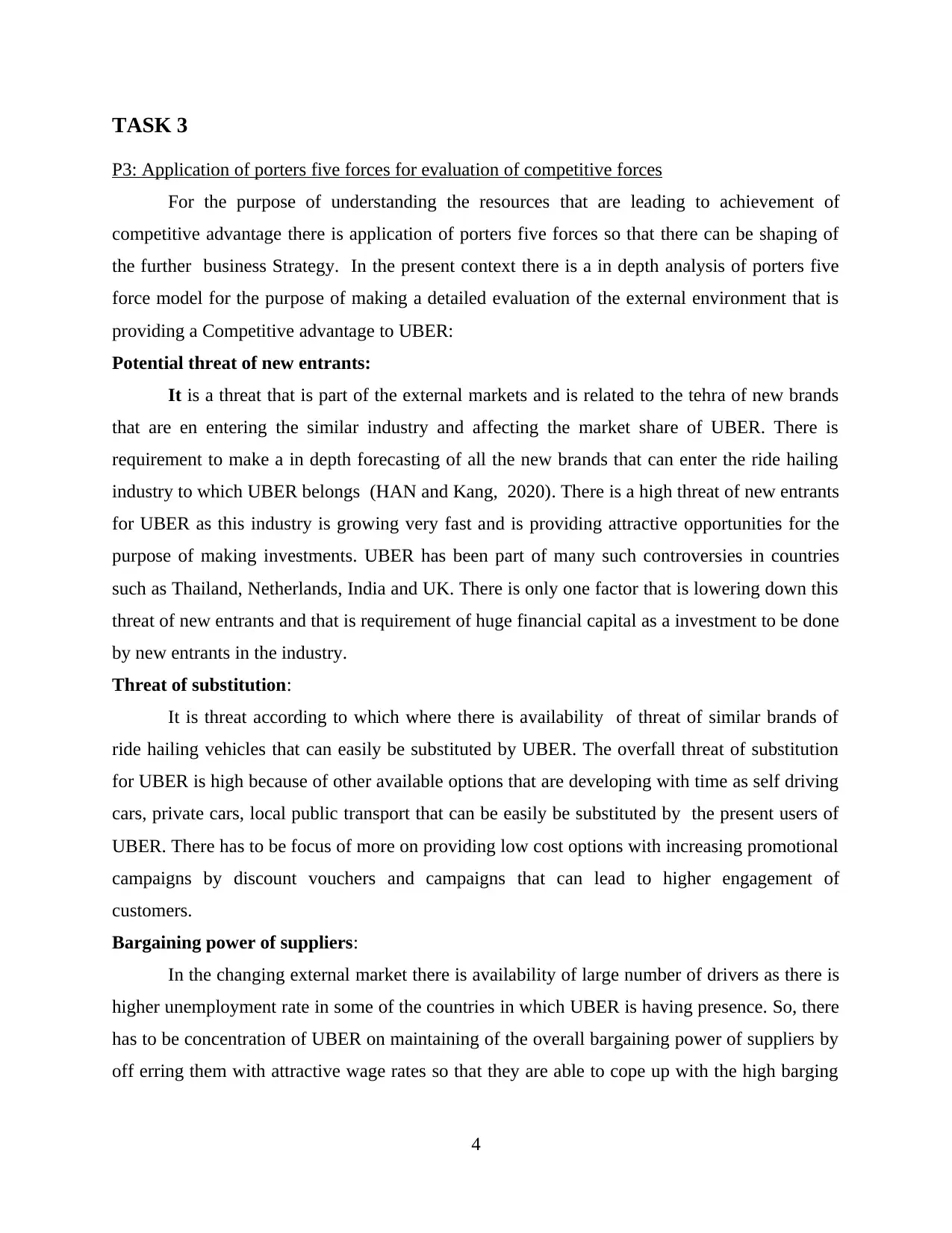
TASK 3
P3: Application of porters five forces for evaluation of competitive forces
For the purpose of understanding the resources that are leading to achievement of
competitive advantage there is application of porters five forces so that there can be shaping of
the further business Strategy. In the present context there is a in depth analysis of porters five
force model for the purpose of making a detailed evaluation of the external environment that is
providing a Competitive advantage to UBER:
Potential threat of new entrants:
It is a threat that is part of the external markets and is related to the tehra of new brands
that are en entering the similar industry and affecting the market share of UBER. There is
requirement to make a in depth forecasting of all the new brands that can enter the ride hailing
industry to which UBER belongs (HAN and Kang, 2020). There is a high threat of new entrants
for UBER as this industry is growing very fast and is providing attractive opportunities for the
purpose of making investments. UBER has been part of many such controversies in countries
such as Thailand, Netherlands, India and UK. There is only one factor that is lowering down this
threat of new entrants and that is requirement of huge financial capital as a investment to be done
by new entrants in the industry.
Threat of substitution:
It is threat according to which where there is availability of threat of similar brands of
ride hailing vehicles that can easily be substituted by UBER. The overfall threat of substitution
for UBER is high because of other available options that are developing with time as self driving
cars, private cars, local public transport that can be easily be substituted by the present users of
UBER. There has to be focus of more on providing low cost options with increasing promotional
campaigns by discount vouchers and campaigns that can lead to higher engagement of
customers.
Bargaining power of suppliers:
In the changing external market there is availability of large number of drivers as there is
higher unemployment rate in some of the countries in which UBER is having presence. So, there
has to be concentration of UBER on maintaining of the overall bargaining power of suppliers by
off erring them with attractive wage rates so that they are able to cope up with the high barging
4
P3: Application of porters five forces for evaluation of competitive forces
For the purpose of understanding the resources that are leading to achievement of
competitive advantage there is application of porters five forces so that there can be shaping of
the further business Strategy. In the present context there is a in depth analysis of porters five
force model for the purpose of making a detailed evaluation of the external environment that is
providing a Competitive advantage to UBER:
Potential threat of new entrants:
It is a threat that is part of the external markets and is related to the tehra of new brands
that are en entering the similar industry and affecting the market share of UBER. There is
requirement to make a in depth forecasting of all the new brands that can enter the ride hailing
industry to which UBER belongs (HAN and Kang, 2020). There is a high threat of new entrants
for UBER as this industry is growing very fast and is providing attractive opportunities for the
purpose of making investments. UBER has been part of many such controversies in countries
such as Thailand, Netherlands, India and UK. There is only one factor that is lowering down this
threat of new entrants and that is requirement of huge financial capital as a investment to be done
by new entrants in the industry.
Threat of substitution:
It is threat according to which where there is availability of threat of similar brands of
ride hailing vehicles that can easily be substituted by UBER. The overfall threat of substitution
for UBER is high because of other available options that are developing with time as self driving
cars, private cars, local public transport that can be easily be substituted by the present users of
UBER. There has to be focus of more on providing low cost options with increasing promotional
campaigns by discount vouchers and campaigns that can lead to higher engagement of
customers.
Bargaining power of suppliers:
In the changing external market there is availability of large number of drivers as there is
higher unemployment rate in some of the countries in which UBER is having presence. So, there
has to be concentration of UBER on maintaining of the overall bargaining power of suppliers by
off erring them with attractive wage rates so that they are able to cope up with the high barging
4
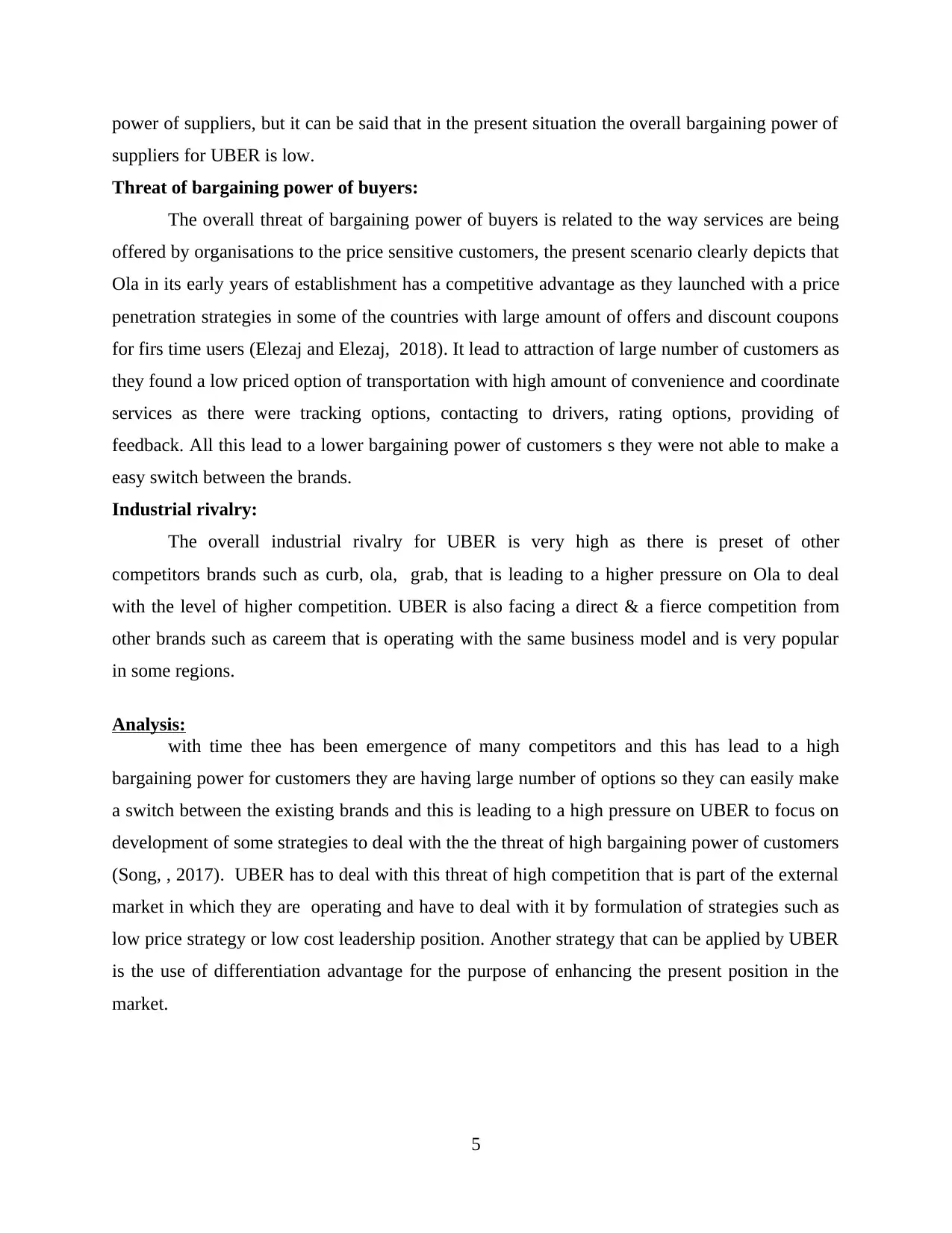
power of suppliers, but it can be said that in the present situation the overall bargaining power of
suppliers for UBER is low.
Threat of bargaining power of buyers:
The overall threat of bargaining power of buyers is related to the way services are being
offered by organisations to the price sensitive customers, the present scenario clearly depicts that
Ola in its early years of establishment has a competitive advantage as they launched with a price
penetration strategies in some of the countries with large amount of offers and discount coupons
for firs time users (Elezaj and Elezaj, 2018). It lead to attraction of large number of customers as
they found a low priced option of transportation with high amount of convenience and coordinate
services as there were tracking options, contacting to drivers, rating options, providing of
feedback. All this lead to a lower bargaining power of customers s they were not able to make a
easy switch between the brands.
Industrial rivalry:
The overall industrial rivalry for UBER is very high as there is preset of other
competitors brands such as curb, ola, grab, that is leading to a higher pressure on Ola to deal
with the level of higher competition. UBER is also facing a direct & a fierce competition from
other brands such as careem that is operating with the same business model and is very popular
in some regions.
Analysis:
with time thee has been emergence of many competitors and this has lead to a high
bargaining power for customers they are having large number of options so they can easily make
a switch between the existing brands and this is leading to a high pressure on UBER to focus on
development of some strategies to deal with the the threat of high bargaining power of customers
(Song, , 2017). UBER has to deal with this threat of high competition that is part of the external
market in which they are operating and have to deal with it by formulation of strategies such as
low price strategy or low cost leadership position. Another strategy that can be applied by UBER
is the use of differentiation advantage for the purpose of enhancing the present position in the
market.
5
suppliers for UBER is low.
Threat of bargaining power of buyers:
The overall threat of bargaining power of buyers is related to the way services are being
offered by organisations to the price sensitive customers, the present scenario clearly depicts that
Ola in its early years of establishment has a competitive advantage as they launched with a price
penetration strategies in some of the countries with large amount of offers and discount coupons
for firs time users (Elezaj and Elezaj, 2018). It lead to attraction of large number of customers as
they found a low priced option of transportation with high amount of convenience and coordinate
services as there were tracking options, contacting to drivers, rating options, providing of
feedback. All this lead to a lower bargaining power of customers s they were not able to make a
easy switch between the brands.
Industrial rivalry:
The overall industrial rivalry for UBER is very high as there is preset of other
competitors brands such as curb, ola, grab, that is leading to a higher pressure on Ola to deal
with the level of higher competition. UBER is also facing a direct & a fierce competition from
other brands such as careem that is operating with the same business model and is very popular
in some regions.
Analysis:
with time thee has been emergence of many competitors and this has lead to a high
bargaining power for customers they are having large number of options so they can easily make
a switch between the existing brands and this is leading to a high pressure on UBER to focus on
development of some strategies to deal with the the threat of high bargaining power of customers
(Song, , 2017). UBER has to deal with this threat of high competition that is part of the external
market in which they are operating and have to deal with it by formulation of strategies such as
low price strategy or low cost leadership position. Another strategy that can be applied by UBER
is the use of differentiation advantage for the purpose of enhancing the present position in the
market.
5
⊘ This is a preview!⊘
Do you want full access?
Subscribe today to unlock all pages.

Trusted by 1+ million students worldwide
1 out of 19
Related Documents
Your All-in-One AI-Powered Toolkit for Academic Success.
+13062052269
info@desklib.com
Available 24*7 on WhatsApp / Email
![[object Object]](/_next/static/media/star-bottom.7253800d.svg)
Unlock your academic potential
Copyright © 2020–2025 A2Z Services. All Rights Reserved. Developed and managed by ZUCOL.





